Small Internet Protocol Stack using a standard serial port.
PPP-Blinky - TCP/IP Networking Over a Serial Port
Note: The source code is at the bottom of this page.
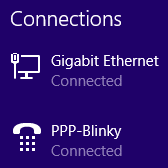
A Windows desktop showing PPP-Blinky in the network connections list.
Describe PPP-Blinky in Three Sentences
PPP-Blinky is a tiny library that enables Internet protocols (IPv4) to any mbed target hardware by using only a serial port.
The code runs on processors with as little as 8k RAM, for example the Nucleo-L053R8 board.
PPP-Blinky uses the industry-standard PPP (Point-to-Point) Protocol and a tiny "stateless" TCP/IP stack.
No Ethernet Port Required
No ethernet port is required - PPP-Blinky uses a serial port to send IP packets to your PC.
PPP-Blinky emulates a standard dial-up modem and therefore connects to Windows, Linux or Adroid machines.
The code runs on most ARM mbed platforms such as the LPC11U24 shown in the picture below:
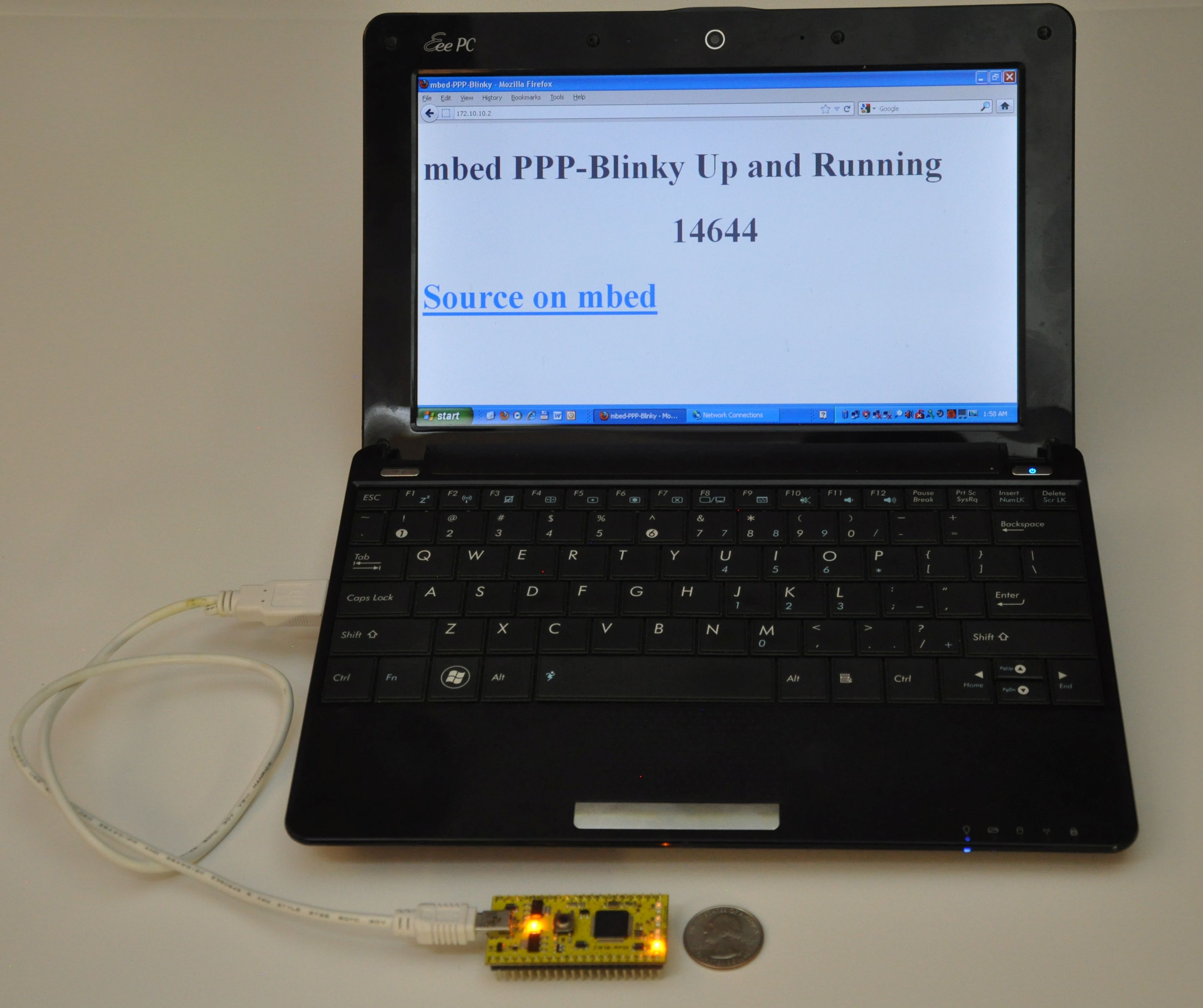 mbed LPC11u24 acting as a webserver to a Windows laptop.
mbed LPC11u24 acting as a webserver to a Windows laptop.
Webserver
The Webserver and WebSocket functions are ideal for building browser-based GUIs on mbed-enabled hardware.
PPP-Blinky's HTTP webserver works with most web clients such as Internet Explorer, Mozilla Firefox, Google Chrome, Safari, Curl, wget and Lynx as well as Microsoft Powershell Invoke-Webrequest command.
In the image below Firefox web browser displays the main web page embedded into PPP-Blinky's code:
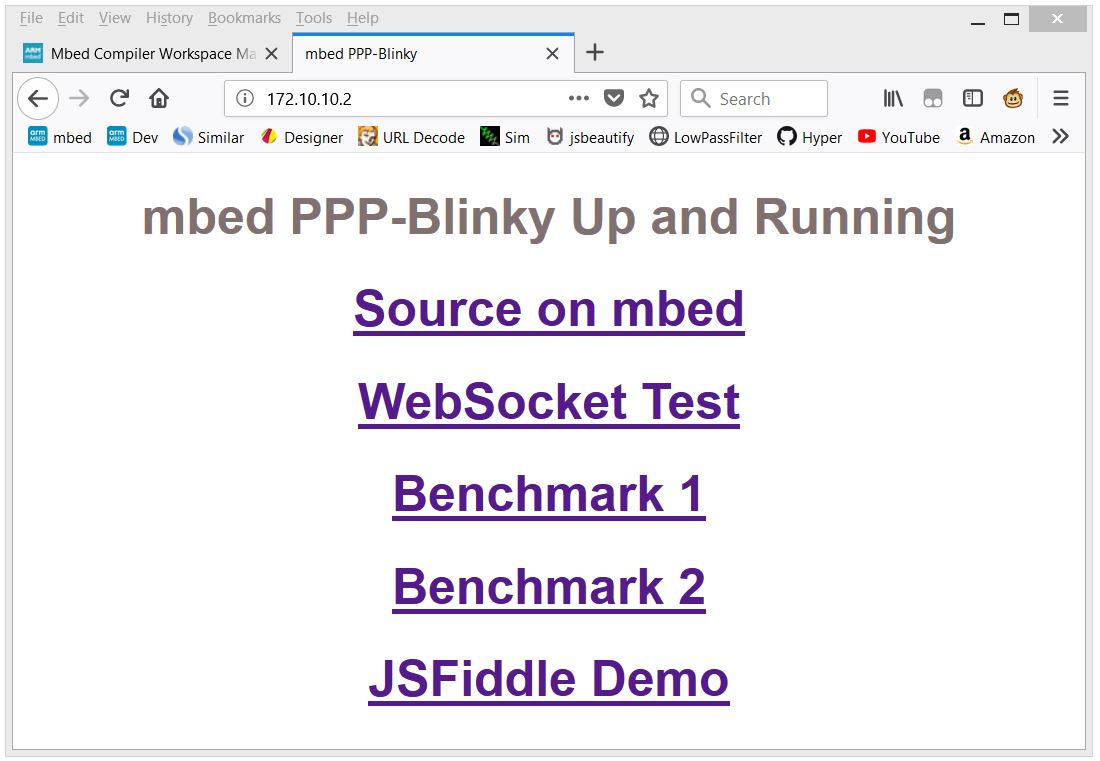 Firefox web browser displays a web page embedded into PPP-Blinky's code
Firefox web browser displays a web page embedded into PPP-Blinky's code
WebSocket Service
WebSocket is the most popular protocol standard for real-time bidirectional TCP/IP communication between clients and servers.
In the image below a small Internet Explorer script has connected to PPP-Blinky's WebSocket Service.
A websocket message was then sent by the browser and was echoed back by the WebSocket, triggering the onmessage event in the script.
The WebSocket service enables bidirectional real-time interaction between PPP-Blinky and any element in the browser DOM via JavaScript.
If you already have PPP-Blinky up and running you can test your WebSocket service using this: http://jsfiddle.net/d26cyuh2/112/embedded/result
Websockets are ideal for building browser-based GUIs for mbed hardware.
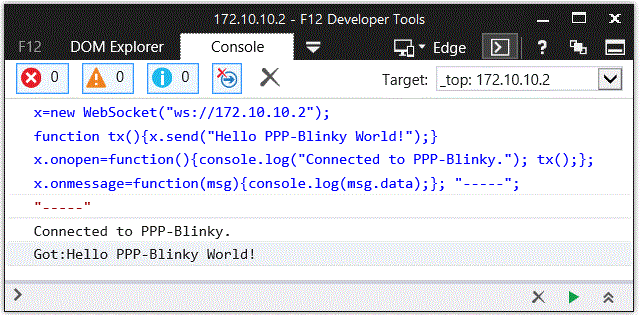
Trying PPP-Blinky on your mbed board
You will need an mbed-enabled hardware board: https://developer.mbed.org/platforms/
Establish a serial port connection between your host PC and your mbed board.
The easiest way is to use mbed hardware with a USB serial debug port. I've tried the ST-Micro Nucleo-L476RG, Nucleo-L152RE, Nucleo-F401RE, Nucleo-L432KC, Nucleo-L053R8, mbed-LPC11U24 and mbed-LPC1768 boards and they all work out of the box. Use the mbed online compiler to compile the software for your target board. Save the compiled binary to your hardware.
Before establishing a network connection, you can verify the operation of the code by opening a terminal program such as Tera Term, and setting the baud rate of the COM port on your mbed board to 115200 baud. LED1 should toggle for every two 0x7E (~) (i.e. tilde) characters you type, as 0x7E is the PPP frame start/end marker. Don't forget to close the port when your'e done testing, or else Windows Dial-up Networking will report that the COM port is in use by another program when you try to connect.
Once you are certain that the serial port and firmware is working, proceed to creating a new network connection on your PC -see below.
Creating a Dial-up Connection in Windows

Setting up Dial-Up Networking (DUN) on your Windows 7 or 8 PC is essentially a two-step process: First, you create a new modem device, because PPP-blinky partially emulates a standard Windows serial port modem device. Second, you create a new Internet connection (in practice, a new network adapter) which is associated with your new "modem".
Step-by-step description of how to configure Windows for PPP-Blinky here:
/users/nixnax/code/PPP-Blinky/wiki/Configuring-Windows-Dial-Up-Networking
There is also a screen on how to set up Linux dial-up networking near the bottom of this page.
Connecting to PPP-Blinky from your PC
Once Windows networking is configured you can establish a dial-up connection to your mbed board over the USB virtual com port.
The IP address you manually assigned to the new dial-up network adapter (172.10.10.1) functions as a gateway to any valid IP address on that subnet. In the screen capture below, I'm sending pings from the Windows 8 command line to my ST-Micro Nucleo-L476RG board over the USB virtual serial Port. I'm also using a second serial port and Tera Term to capture the debug output from a second serial port on the hardware. The optional debug output from the board prints out the IP source and destination address and the first few bytes of the data payload. Note that the source is the adapter IP address, (172.10.10.1 in this case) and the destination is some other address on that subnet - all packets to the subnet are sent to our mbed hardware. For example, you could also ping 172.10.10.123 or, if your PPP-Blinky is running, simply click on this link: http://172.10.10.123
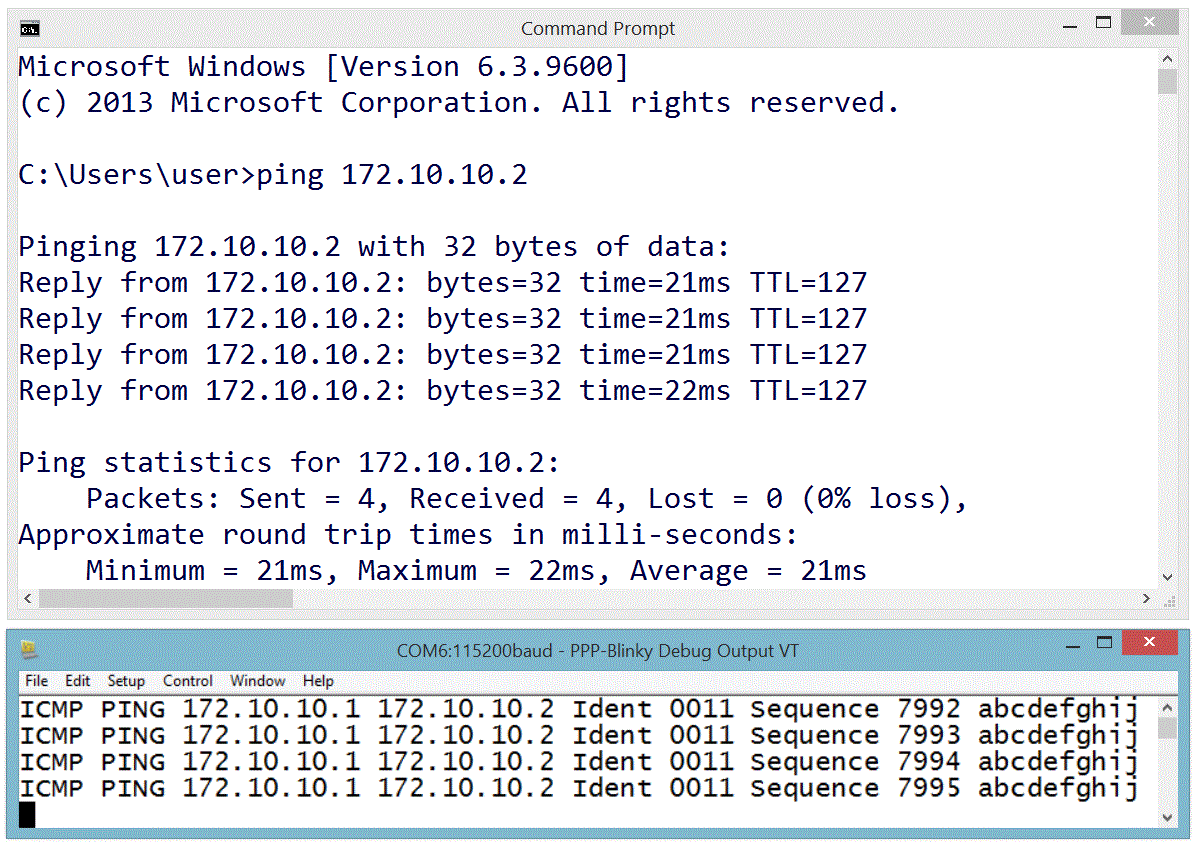
One Million Pings!
In the image below the ICMP ("ping") echo reply service was tested by sending one million pings to ppp-Blinky. This took over two hours.
The ping tool used on the Windows 8 PC was psping.exe from PsTools by Mark Russinovich - http://bit.ly/PingFast
The average reply time for a short ping (1 byte of payload data) was 11 milliseconds at 115200 baud on the $10 Nucleo-L053R8 board - barely enough time for 130 bytes to be sent over the port!
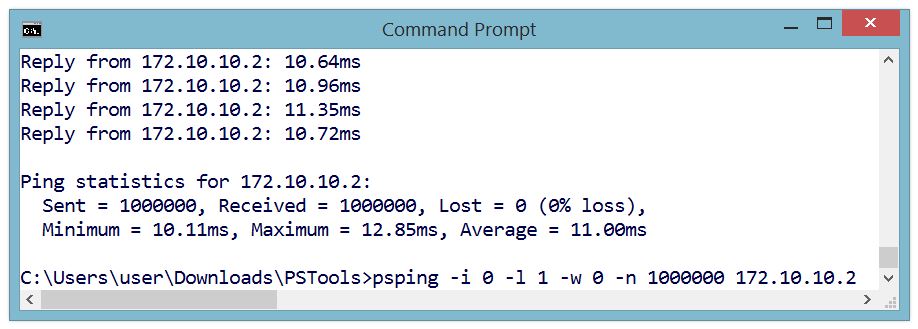
Monitoring PPP-Blinky Packets
The image below is from a Microsoft Network Monitor 3.4 capture session.
Responses from PPP-Blinky are shown in blue.
Frame 2 - Internet Explorer at IP 172.10.10.1 (the Dial-Up Adapter IP) requests a TCP connection by sending an S (SYN) flag.
Frame 3 - PPP-Blinky at IP 172.10.10.2 responds with an ACK in frame 3. One direction of the link is now established.
Frame 4 - The PC acknowledges the SYN sent by PPP-Blinky in frame 3. The TCP link is now fully established.
Frame 5 - The browser "pushes" (P flag is set) an HTTP GET request to PPP-Blinky.
Frame 6 - PPP-Blinky responds with a standard HTTP response "pushes" (P flag set) back a small web page. It also sets the A (ACK) flag to acknowledge the message sent in frame 6.
Frame 7 - The PC acknowledges reception of the HTTP payload.
Frame 8 - The PC starts to shut down the TCP connection by sending a FIN flag.
Frame 9 - PPP-Blinky acknowledges the FIN request - the connection is now closed in one direction. It also sets a FIN flag in the response to request closure of the opposite direction of the connection.
Frame 10 - The PC acknowledges the FIN request. The closing of the TCP connection is now confirmed in both directions.
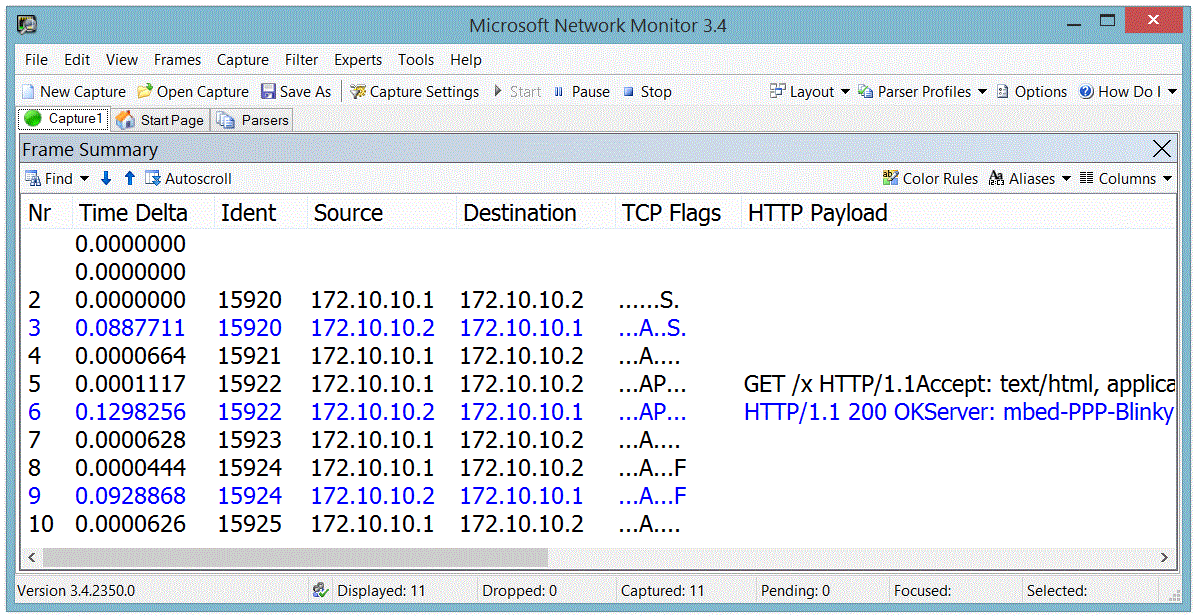
Debug Output
PPP-Blinky can output handy debug information to an optional second serial port.
The image below shows the debug output (Ident, Source, Destination, TCP Flags) for a complete HTTP conversation.
The PC messages are displayed in black. PPP-Blinky messages are blue.
Notice how PPP-blinky automatically inserts a blank line after each full HTTP conversation.
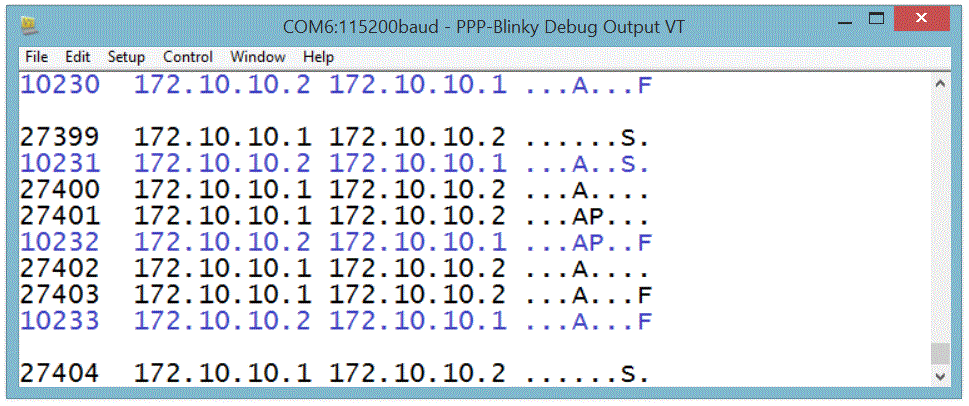
Creating a Dial-Up Connection in Linux
The screen below shows the required pppd command to connect to PPP-Blinky from a Linux machine. This was much simpler than Windows! The USB serial port of the mbed LPC1768 board registered as /dev/ttyACM0 on my Linux box. Do a websearch on pppd if you want to learn more about pppd, the Linux PPP handler. Near the bottom of the screen below, two webpages are fetched (/ and /y) by using the curl command on the command line. Gnome Webkit and Firefox work fine, too. Also try echo GET / HTTP/1.1 | nc 172.10.10.2 which uses netcat, the "Swiss army knife" of networking tools. PPP-Blinky was also tested with ApacheBench, the Apache server benchmark software. After 100000 fetches, the mean page fetch rate was reported as 6 page fetches per second for a small page.
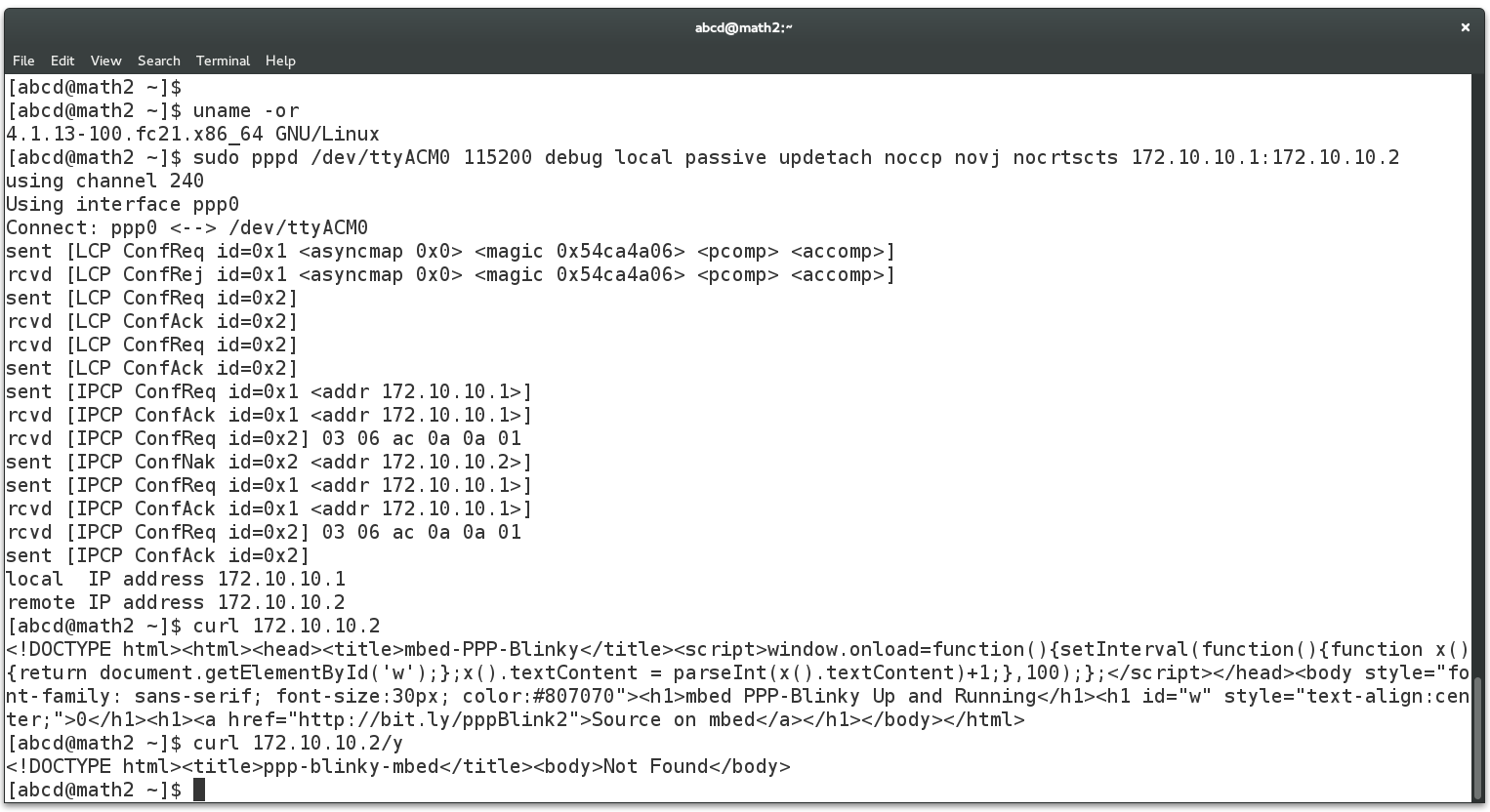
Caveats
PPP Blinky is an extremely sparse implementation (1.5k lines) of HTTP,WebSocket,TCP, UDP, ICMP, IPCP and LCP over PPP, requiring around 8kB of RAM. The minimum functionality required to establish connectivity is implemented. These are often acceptable tradeoffs for embedded projects as well as a handy tool to learn the practical details of everyday networking implementations.
Diff: main.cpp
- Revision:
- 38:ab582987926e
- Parent:
- 37:2e6689f8b181
- Child:
- 39:b90183d35f1e
--- a/main.cpp Thu Jan 05 10:37:48 2017 +0000
+++ b/main.cpp Thu Jan 05 17:12:57 2017 +0000
@@ -47,25 +47,21 @@
// a structure to keep all our ppp globals in
struct pppType {
- int online;
- int ident;
- int sync;
- unsigned int seq;
- int crc;
- int ledState;
- int oldFlags;
+ int online; // we hunt for a PPP connection if this is zero
+ int ident; // our IP ident value
+ unsigned int seq; // our TCP sequence number
+ int crc; // for calculating IP and TCP CRCs
+ int ledState; // state of LED1
struct {
char * buf;
volatile int head;
volatile int tail;
- int total;
- } rx; // serial port buffer
+ } rx; // serial port objects
struct {
- int id;
- int len;
- int crc;
- char * buf;
- } pkt; // ppp buffer
+ int len; // number of bytes in buffer
+ int crc; // PPP CRC (frame check)
+ char * buf; // the actual buffer
+ } pkt; // ppp buffer objects
};
pppType ppp; // our global - definitely not thread safe
@@ -77,14 +73,11 @@
ppp.rx.buf=rxbuf;
ppp.rx.tail=0;
ppp.rx.head=0;
- ppp.rx.total=0;
ppp.pkt.buf=frbuf;
ppp.pkt.len=0;
ppp.ident=0;
- ppp.sync=0;
ppp.seq=1000;
ppp.ledState=0;
- ppp.oldFlags=0;
}
void crcReset()
@@ -142,11 +135,9 @@
} else return -1;
}
-void scanForConnectString(); // scan for connect attempts from pc
-
void processFrame(int start, int end) // process received frame
{
- led1Toggle(); // change led1 state when frames are received
+ led1Toggle(); // change led1 state on every frame we receive
if(start==end) {
pc.putc(0x7e);
return;
@@ -184,9 +175,9 @@
}
}
-// Note - the hex output of dumpframe can be imported into WireShark
-// Copy the frame's hex output from your terminal program and save as a text file
-// In WireShark, use "Import Hex File". Options are No Offset, protocol=PPP.
+// Note - the hex output of dumpFrame() can be imported into WireShark
+// Capture the frame's hex output in your terminal program and save as a text file
+// In WireShark, use "Import Hex File". Options are: Offset=None, Protocol=PPP.
void dumpFrame()
{
for(int i=0; i<ppp.pkt.len; i++) debug(("%02x ", ppp.pkt.buf[i]));
@@ -197,13 +188,13 @@
{
if ( (ch<0x20) || (ch==0x7d) || (ch==0x7e) ) {
pc.putc(0x7d);
- pc.putc(ch^0x20);
+ pc.putc(ch^0x20); // three characters need special handling
} else {
pc.putc(ch);
}
}
-void sendFrame()
+void sendFrame() // send one PPP frame in HDLC format
{
int crc = crcBuf(ppp.pkt.buf, ppp.pkt.len-2); // update crc
ppp.pkt.buf[ ppp.pkt.len-2 ] = (~crc>>0); // fcs lo (crc)
@@ -303,7 +294,7 @@
int sum=0;
int placeHolder;
if (len&1) {
- placeHolder = ptr[len-1]; // when length is odd zero stuff
+ placeHolder = ptr[len-1]; // when length is odd stuff in a zero byte
ptr[len-1]=0;
}
for (int i=0; i<len/2; i++) {
@@ -438,8 +429,8 @@
snprintf(srcIP,16, "%d.%d.%d.%d", srcAdr[0],srcAdr[1],srcAdr[2],srcAdr[3]);
char dstIP [16];
snprintf(dstIP,16, "%d.%d.%d.%d", dstAdr[0],dstAdr[1],dstAdr[2],dstAdr[3]);
- debug(("IP %s %s v%d h%d d%d e%d L%d ",srcIP,dstIP,versionIP,headerSizeIP,dscpIP,ecnIP,packetLength));
- if (v1) debug(("i%04x f%d t%d p%d C%04x\n",identIP,flagsIP,ttlIP,protocolIP,checksumIP));
+ if (v0) debug(("IP %s %s v%d h%d d%d e%d L%d ",srcIP,dstIP,versionIP,headerSizeIP,dscpIP,ecnIP,packetLength));
+ if (v0) debug(("i%04x f%d t%d p%d C%04x\n",identIP,flagsIP,ttlIP,protocolIP,checksumIP));
}
void dumpHeaderTCP()
@@ -512,27 +503,35 @@
#define TCP_FLAG_RST (1<<2)
#define TCP_FLAG_FIN (1<<0)
- // A sparse TCP flag interpreter that implements basic TCP connections from a single source
+ // A sparse TCP flag interpreter that implements simple TCP connections from a single source
+ // Clients are allowed ONE push packet, after which the link is closed with a FIN flag in the ACK packet
+ // This strategy allows web browsers, netcat and curl to work ok while keeping the state machine simple
int dataLen = 0; // most of our responses will have zero TCP data, only a header
- int flagsOut = TCP_FLAG_ACK; // the default case is an ack
- int fastResponse = 0; // normally we wait 200ms before sending but this can make it faster
+ int flagsOut = TCP_FLAG_ACK; // the default case is an ACK packet
+ int fastResponse = 0; // normally you wait 200ms before sending a packet but this can make it faster
+
+ if (ppp.seq != ack) {
+ ppp.seq = ack; // if their sequence number is different than our calculation we adopt their version
+ }
if ( ((flagsTCP & ~TCP_FLAG_ACK) == 0) && ((flagsTCP & TCP_FLAG_ACK) != 0) ) {
- if (incomingLen == 0) return; // no new data
- } else if ( (flagsTCP & TCP_FLAG_FIN) != 0 ) { // got FIN
- if ((ppp.oldFlags & TCP_FLAG_FIN) !=0) return;
- seq++; // increase sequence by 1 for FIN and SYNC
- } else if ( (flagsTCP & TCP_FLAG_SYN) != 0 ) { // got SYN
+ if (incomingLen == 0) { // ignore - just an empty ack packet
+ return;
+ }
+ } else if ( (flagsTCP & TCP_FLAG_SYN) != 0 ) { // got SYN flag
flagsOut = TCP_FLAG_SYN | TCP_FLAG_ACK; // do a syn-ack
- seq++; // increase sequency by for FIN and SYN
- } else if ( (flagsTCP & TCP_FLAG_PSH) != 0 ) { // they are pushing data
- fastResponse = 1; // we can response fast to a push
- // It's a push - let's check the data for an HTTP home page GET request
+ seq++; // for SYN flag we have to increase sequence by 1
+ } else if ( (flagsTCP & TCP_FLAG_FIN) != 0 ) { // got FIN flag
+ seq++; // for FIN flag we have to increase sequence by 1
+ } else if ( (flagsTCP & TCP_FLAG_PSH) != 0 ) { // got PSH flag (push)
+ flagsOut = TCP_FLAG_ACK | TCP_FLAG_FIN; // for every push we answer once AND close the link
+ fastResponse = 1; // we can respond fast to a push
+ // It's a push, so let's check the incoming data for an HTTP GET request
if ( strncmp(dataStart, "GET / HTTP/1.1", 14) == 0) {
dataLen = 15*32; // this block has to hold the web page below, but keep it under 1k
- memset(dataStart,'x', dataLen ); // initialize the block
- int n=1; // number of bytes we have printed so far
+ memset(dataStart,'x', dataLen ); // initialize the data block
+ int n=0; // number of bytes we have printed so far
n=n+sprintf(n+dataStart,"HTTP/1.1 200 OK\r\nServer: PPP-Blinky\r\n"); // http header
n=n+sprintf(n+dataStart,"Content-Length: 376\r\n"); // http header
n=n+sprintf(n+dataStart,"Content-Type: text/html; charset=us-ascii\r\n\r\n"); // http header
@@ -547,11 +546,11 @@
if (v0) {
debug(("HTTP GET dataLen %d*32=%d Header %d Content-Length %d Total %d Margin %d\n",dataLen/32,dataLen,nHeader,contentLength,n,dataLen-n));
}
- } else if ( strncmp(dataStart, "GET /", 4) == 0) { // all other files get 404 not found
- dataLen = 5*32; // this block has to hold the web page below, but keep it under 1k
- memset(dataStart,'x', dataLen ); // initialize the block
- int n=0;
- n=n+sprintf(n+dataStart,"HTTP/1.1 200 OK\r\nServer: PPP-Blinky\r\n"); // http header
+ } else if ( strncmp(dataStart, "GET /", 4) == 0) { // all other HTTP GET requests get 404 Not Found response
+ dataLen = 5*32; // block size for File not found webpage
+ memset(dataStart,'x', dataLen ); // initialize the data block
+ int n=0; // number of bytes we have printed so far
+ n=n+sprintf(n+dataStart,"HTTP/1.1 400 Not Found\r\nServer: PPP-Blinky\r\n"); // http header
n=n+sprintf(n+dataStart,"Content-Length: 58\r\n"); // http header
n=n+sprintf(n+dataStart,"Content-Type: text/html; charset=us-ascii\r\n\r\n"); // http header
int nHeader=n; // byte total of all headers
@@ -563,80 +562,80 @@
debug(("HTTP GET dataLen %d*32=%d Header %d Content-Length %d Total %d Margin %d\n",dataLen/32,dataLen,nHeader,contentLength,n,dataLen-n));
}
} else {
- dataLen=0;
+ dataLen=0; // we did not find a valid HTTP request, so just ACK with zero data
}
} else {
- dataLen=0;
+ dataLen=0; // it's not any TCP Flag Combo that needs special handling
}
- // All the flag checking is now donw
-
- ppp.oldFlags = flagsTCP; // remember the flags for the next round
-
- // Now we have to recalculate all the header sizes
+ // All the TCP flag handling is now done
- ack = seq + incomingLen; // acknowledge the number of bytes they sent by adding it to seq
- seq = ppp.seq;
+ // Now we have to recalculate all the header sizes, swap IP address/port source and destination, and do the IP and TCP checksums
- char src[4];
- char dst[4];
+ char src[4]; // temp hold
+ char dst[4]; // temp hold
memcpy(src, srcAdr,4);
memcpy(dst, dstAdr,4);
memcpy(srcAdr, dst,4);
memcpy(dstAdr, src,4); // swap ip address source/dest
- char psrc[2];
- char pdst[2];
+
+ char psrc[2]; // temp hold
+ char pdst[2]; // temp hold
memcpy(psrc, srctcp,2);
memcpy(pdst, dsttcp,2);
memcpy(srctcp, pdst,2);
memcpy(dsttcp, psrc,2); // swap ip port source/dest
- int newPacketSize = headerSizeIP + headerSizeTCP + dataLen;
+ ack = seq + incomingLen; // acknowledge the number of bytes that they sent by adding it to "our" sequence number
+ seq = ppp.seq; // set up the sequence number we have to respond with
+
+ acktcp[0]=ack>>24;
+ acktcp[1]=ack>>16;
+ acktcp[2]=ack>>8;
+ acktcp[3]=ack>>0; // save ack
+
+ seqtcp[0]=seq>>24;
+ seqtcp[1]=seq>>16;
+ seqtcp[2]=seq>>8;
+ seqtcp[3]=seq>>0; // save seq
+
+ flagbitstcp[1] = flagsOut; // set up the new flags
+
+ int newPacketSize = headerSizeIP + headerSizeTCP + dataLen; // calculate size of the outgoing packet
pktLen[0] = (newPacketSize>>8);
pktLen[1]=newPacketSize; // ip total packet size
ppp.pkt.len = newPacketSize+6; // ppp packet length
tcpSize = headerSizeTCP + dataLen; // tcp packet size
- flagbitstcp[1] = flagsOut; // set up the new flags
-
- acktcp[0]=ack>>24;
- acktcp[1]=ack>>16;
- acktcp[2]=ack>>8;
- acktcp[3]=ack>>0; // save ack
- seqtcp[0]=seq>>24;
- seqtcp[1]=seq>>16;
- seqtcp[2]=seq>>8;
- seqtcp[3]=seq>>0; // save seq
-
-
- // redo all the header stuff
+ // the header is all set up, now do the IP and TCP checksums
headercheck[0]=0;
headercheck[1]=0;
headerCheckSum(); // redo the ip header checksum
- char pseudoHeader[12];
+
+ char pseudoHeader[12]; // we are building a fake TCP header
int sum;
- char temp[12]; // for the terrible pseudoheader checksum
memcpy( pseudoHeader+0, srcAdr, 8); // source and destination addresses.
pseudoHeader[8]=0;
pseudoHeader[9]=protocol[0];
pseudoHeader[10]=tcpSize>>8;
pseudoHeader[11]=tcpSize;
- memcpy(temp, s-12, 12); // keep a copy
- memcpy( s-12, pseudoHeader, 12); // put the header on the tcp packet
+ char temp[12]; // temporary storage for the 12 bytes that are in the way
+ memcpy(temp, s-12, 12); // save the 12 bytes that are in the way
+ memcpy( s-12, pseudoHeader, 12); // copy in the fake header
checksumtcp[0]=0;
checksumtcp[1]=0;
- sum=dataCheckSum(s-12,tcpSize+12); // update TCP checksum
+ sum=dataCheckSum(s-12,tcpSize+12); // calculate the TCP checksum
checksumtcp[0]=sum>>8;
checksumtcp[1]=sum;
- memcpy( s-12, temp, 12); // overwrite the pseudoheader
+ memcpy( s-12, temp, 12); // restore the 12 bytes that the fake header overwrote
if (fastResponse==1) {
fastResponse=0; // reset and skip 200 ms wait
} else {
- wait(0.2); // wait 200 ms before sending packet
+ wait(0.2); // normally, you wait 200 ms before sending a TCP packet
}
- sendFrame(); // return the TCP packet
- ppp.seq = ppp.seq + dataLen; // increase OUR sequence by outgoing data length - for the next round
+ sendFrame(); // All done! Send the TCP packet
+ ppp.seq = ppp.seq + dataLen; // increase OUR sequence by the outgoing data length - for the next round
}
void dumpDataTCP()
 Nicolas Nackel
Nicolas Nackel